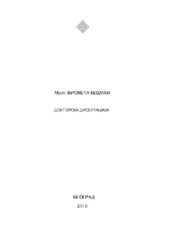Приказ основних података о запису
МЕДИЈСКА ПИСМЕНОСТ У СРЕДЊЕМ ОБРАЗОВАЊУ: Подстицај за критичко мишљење адолесцената у Србији почетком 21. века
| dc.contributor.advisor | Вуксановић, др Дивна | |
| dc.contributor.other | Маричић, др Никола | |
| dc.contributor.other | Јевтовић, др Зоран | |
| dc.contributor.other | Шкорц, др Бојана | |
| dc.contributor.other | Мартиноли, др Ана | |
| dc.creator | Кецман, Виолета | |
| dc.date.accessioned | 2019-12-23T12:37:41Z | |
| dc.date.available | 2019-12-23T12:37:41Z | |
| dc.date.issued | 2020-06-05 | |
| dc.date.submitted | 2019-12-20 | |
| dc.identifier.uri | http://eteze.arts.bg.ac.rs/handle/123456789/433 | |
| dc.description.abstract | Дигитална култура на почетку 21. века доноси потребу за преиспитивањем постојећих концепата образовања. Нова епоха захтева способност критичке перцепције моћних слика мултимедијалне културе, разумевање њиховог значења и медијске продукције. Циљ ове докторске дисертације је доказивање хипотезе да медијска писменост у средњем образовању подстиче критичко мишљење адолесцената о медијским садржајима. Медијску писменост у раду посматрамо као један од циљева наставе у оквирима средњег (гимназијског) образовања. Емпиријско истраживање, чији ће резултати бити коришћени за доказивање главне и помоћних хипотеза, усмерено је на испитивање когнитивне димензије критичког мишљења и критичке рецепције код адолесцената. Покушано је да се утврди у којој мери је већи степен присуства сваке од пет субскала критичког мишљења – евалуације аргумената, препознавања имплицитних претпоставки, дедуктивног резоновања, закључивања и тумачења информација (интерпретације), код испитаника стимулисаним медијским садржајима кроз наставу медијске писмености. За пилот-истраживање коришћен је Вотсон-Глесеров тест (Watson-Glaser Critical Thinking Appraisal – WGCTA). Инструмент за главно емпиријско истраживање – Тест критичке рецепције медијских садржаја, креиран је за потребе ове дисертације. Некогнитивна димензија критичког мишљења и критичка продукција адолесцената представљене су анализом креативног процеса и уметничког продукта – позоришне представе Невидљиви споменици ученика Треће београдске гимназије и Битеф театра. Континуирано стимулисање адолесцената одређеним медијским садржајима у контексту наставе чији је циљ развијање медијске писмености, активира способности и вештине критичког мишљења, пре свега препознавање имплицитних претпоставки и интерпретација. Резултати истраживања спроведеног током јуна 2019. године у пет гимназија у Београду, које је обухватило 250 адолесцената, показују да је критичко разумевање медијских садржаја од стране адолесцената у већој мери присутно код ученика који су пратили наставу чији је циљ развијање медијске писмености ученика. | en |
| dc.description.abstract | Digital culture at the beginning of the 21st century brings the need for reexamining the existing concepts of education. The new epoch requires the ability to critically perceive powerful images of a multimedia culture, to understand their meaning and media production. The goal of this doctoral dissertation is to prove the hypothesis that media literacy in high education fosters the critical thinking of adolescents about media content. We consider media literacy in our work as one of the goals of teaching in high school (gymnasium). Empirical research, whose results will be used to prove the main and auxiliary hypotheses, is aimed at examining the cognitive dimension and critical reception of the critical thinking of adolescents. It has been tried to determine the extent to which the presence of each of the five subcategories of critical thinking – the evaluation of arguments, the recognition of implicit assumptions, deductive reasoning, conclusion and interpretation of information – is enhanced among respondents with stimulated media content through the teaching of media literacy. Watson-Glaser Critical Thinking Appraisal (WGCTA) was used for pilot research. The instrument for the main empirical research – Test of critical reception of media content, was created for the needs of this dissertation. The incognitive dimension of the critical thinking and critical production is illustrated by the analysis of the creative process and the artistic product – the theatrical play Invisible Monuments of students of the Third Belgrade High School and Bitef Theater. Continuous stimulation of adolescents by certain media contents in the context of teaching aimed at developing media literacy, activates the skills of critical thinking, above all recognition of implicit assumptions and interpretation. The results of a survey conducted in June 2019 in five high schools in Belgrade, which included 250 adolescents, show that the critical understanding of media content by adolescents is more present in students who have followed the teaching of media literacy. | en |
| dc.language.iso | sc | en |
| dc.publisher | Универзитет уметности у Београду, Факултет драмских уметности | sr |
| dc.source | Факултет драмских уметности | sr |
| dc.subject | МЕДИЈСКА ПИСМЕНОСТ, КРИТИЧКО МИШЉЕЊЕ, АДОЛЕСЦЕНТИ, СРЕДЊЕ ОБРАЗОВАЊЕ | en |
| dc.subject | MEDIA LITARACY, CRITICAL THINKING, ADOLESCENTS, HIGH SCHOOL | en |
| dc.title | МЕДИЈСКА ПИСМЕНОСТ У СРЕДЊЕМ ОБРАЗОВАЊУ: Подстицај за критичко мишљење адолесцената у Србији почетком 21. века | en |
| dc.type | doctoralThesis | en |
| dcterms.abstract | Vuksanović, dr Divna; Škorc, dr Bojana; Martinoli, dr Ana; Maričić, dr Nikola; Jevtović, dr Zoran; Kecman, Violeta; MEDIJSKA PISMENOST U SREDNjEM OBRAZOVANjU: Podsticaj za kritičko mišljenje adolescenata u Srbiji početkom 21. veka; |

